Features
Beginning in the 1880s the American Industrial Revolution caused a shift from farm to factory, an agricultural economy to industrial economy. A sweep of technological advancements and the mechanization of agriculture, railroad development, electricity and factories spurred the expansion of a market economy.
The rapidly growing market economy drove westward expansion. The U.S. government took military action against Native American tribes, pushing them to reservations for containment and assimilation. The Cheyenne and Arapaho Indian reservation was the third of Indian land openings. Approximately four million acres were opened to settlers on April 19, 1892. In October of that year, T.B. Ferguson took the opportunity to bring his family to the territory of Oklahoma, staking a claim in Watonga to set up shop for his newspaper The Watonga Republican.
The tent city pioneers would work toward building a modern agricultural city but that would take some 10 years. The inhabitants were dependent on receiving critical worldwide news as well as news of the developments in the new territory brought to them by The Watonga Republican. Often times they could not pay for their copy in cash. This news that was read religiously was “paid for in stove wood, potatoes, corn, not the liquid kind, but roasting ears, food for the editor’s family and corn on the cob for the editor’s team of horses.”
“Little could be grown that first year upon sod and settlers had a hard time providing for their families. Cutting cedar posts in the gyp hills, hauling them many miles to El Reno and Kingfisher, was resorted to although forbidden by the federal government. Many were fined for this practice, but the courts were lenient because of the extreme conditions and in most cases the fines were remitted. Considerable cedar of high grade from these hills was purchased and shipped to Germany for use in manufacturing lead pencils. Many years later cement mills were established in these hills for the purpose of using the vast deposits of gypsum in the manufacture of building material”. - They Carried the Torch by Mrs. T.B. Ferguson The local economy also depended on the surrounding wheat production. Later developments by territorial pioneers included three elevators, a creamery and two wagon yards. The Enid and Anadarko Railway was built in 1901-2, USG Plant in 1905 and Wheeler Brother’s Grain 1917.
Labor Day pays tribute to the contribution and achievements of American workers. Americans had a strong work ethic which was easily exploited causing massive unrest in some of the big cities. Congress passed an act making Labor Day a legal holiday in 1894 to repair relationships with American workers. Later this holiday was part of the Uniform Monday Act of 1968 so that it would always be observed on a Monday allowing the opportunity for a three-day break. It is often celebrated with parades, picnics, barbecues and other gatherings and is kind of the last hurrah of summer.
This coming weekend we will be celebrating Labor Day. We can be thankful for the early pioneer’s labor and achievements in our little town of Watonga. At the Ferguson Museum we wish to extend an invitation to you to celebrate with us on Saturday, September 2, from 11 a.m. to 3 p.m. and remember the contributions the Fergusons and others made to our community.
How did Mrs. Ferguson prepare all that corn they were paid in exchange for the newspaper? There will be a free, hands-on demonstration of hand milling corn into meal, an opportunity to sample corn bread baked in a Dutch oven, and corn on the cob smothered in butter and salt for you to eat. You can also tour the Ferguson Home and the old jail. We hope you will join us! You can even bring your horse.

